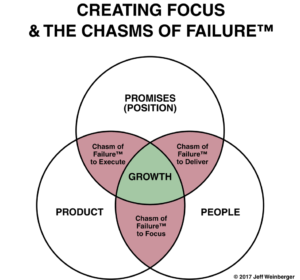In part one of this series, I discussed some of the tactics companies use to create growth and some of the reasons those tactics don’t work as planned: the Chasms of Failure™. In this and the next two parts, I will delve into the three Chasms of Failure, discuss why they are dangerous, show how companies can easily fall into them, and explain how to avoid them and keep your growth on track.
I noted in the last post that the one thing you need for any growth efforts to work is focus. Focus is more than knowing what you do and sticking to it. Focus is knowing whom you do it for, why it’s valuable and what promise(s) it must fulfill to be valuable.
Focus requires that three elements of your business — Promises, People and Product — are in alignment and working toward the same goal.

The Chasm of Failure to Focus is the most common and the easiest to fall into. In simple terms, falling into the Chasm of Failure to Focus means you are delivering on your product plans, and your people are doing a great job, but you don’t know for whom or why.
Bright Shiny Objects
I sometimes call this the bright shiny object problem. You might have a business plan in place that defines your intended target market well, and says exactly what promises you make, to whom and why. If the discipline of focus is not embedded in your organization, however, it’s easy for your people to see opportunities outside the intended target market and start to take advantage of them. Those opportunities are certainly real and viable, but they are not in your target, and in this case, your people are, essentially, wasting time and not delivering on the promises you’ve already made.
The more common cause of failure to focus is either the lack of understanding of your intended (target) customer or the lack of any defined target customer at all. If your business plan says something such as, “We intend to serve any customer who needs the specific features our product has” — it won’t use those words, but it will be that ill-defined — then you don’t have a target customer. If your plans define your target customer by demographics or search criteria (e.g., some number of employees and use of a specific kind of technology), then you don’t have the level of understanding of your customer you need to create focus and ensure focus is embedded in your organization.
The Chasm of Failure to Focus might look something like this:
A mid-sized software company I worked with saw some success in a very broad, not-well-defined market. They decided to use one of the tactics I discussed in part one: more campaigns. They designed and ran more advertising and promotional campaigns. They ran those across more and more media, finding more ways to reach their own lists and the lists they bought.
They had some success. Part of the reason for success was there were specific segments of the market they were addressing who found exceptional value in their offering. But they didn’t know which segments those were. As you might guess, as the number and frequency of the campaigns increased, the return on those campaigns, in terms of engagement and revenue, dropped — slowly at first, then faster as time went on.
When we were able to put into place a strong definition of a target market, develop a specific set of promises, and focus their people and product around fulfilling those promises, suddenly their return on campaigns went up, even when running fewer campaigns. In addition, the value of those customers (measured in revenue) increased, and retention rates decreased.
The people, who were naturally skeptical that thinking smaller helps you grow bigger, started to see the success, and they got better and better at maintaining focus and fulfilling customer promises.
The Way Out of the Chasm of Failure to Focus
In order to create focus, you have to define well what you are choosing to focus on. This is never easy, as it involves the very hard choice of not focusing on something else that seems promising. It’s also important to understand there is not one right choice. There might be several excellent candidate markets in which to focus. But in order to accelerate and scale growth, you need to make the hard choice to focus on one.
That’s not all. Once you make that choice, you must gain a deep understanding of your target customer. Not just their demographics, but their challenges, needs and aspirations. You need to know what keeps them up at night and what delivers personal wins. You need to gain an understanding of the concerns they tell only their most trusted advisers. Then you turn that into promises on which you can deliver, fully and consistently.
Once you know the promises you will make, your whole team can learn to focus on fulfilling those promises. That creates the focus you need to accelerate growth.
In the next two parts of this series, I will discuss the Chasm of Failure to Execute and the Chasm of Failure to Deliver. In the last part, I will discuss discovering and making promises, building customer trust and how to scale your focus to become a market leader.